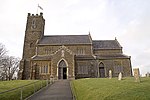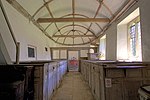Woolsbarrow Hillfort
Dorset geography stubsHill forts in Dorset

Woolsbarrow Hillfort is a hillfort on Bloxworth Heath in the district of Purbeck in the county of Dorset, England. It dates to the period from the Late Bronze Age to the Early Iron Age (8th–5th centuries BC) and is classed as an ancient monument. Despite the hillfort only being at an altitude of 220 feet (67 m) it is said to "dominate the surrounding heathland."
Excerpt from the Wikipedia article Woolsbarrow Hillfort (License: CC BY-SA 3.0, Authors, Images).Woolsbarrow Hillfort
Sika Trail,
Geographical coordinates (GPS) Address External links Nearby Places Show on map
Geographical coordinates (GPS)
| Latitude | Longitude |
|---|---|
| N 50.731408333333 ° | E -2.1530444444444 ° |
Address
Woolsbarrow Fort
Sika Trail
BH20 7NZ , Wareham St. Martin
England, United Kingdom
Open on Google Maps






